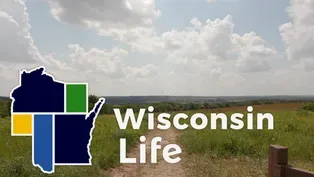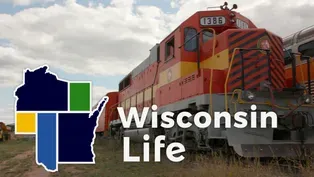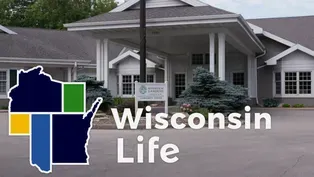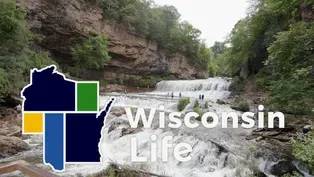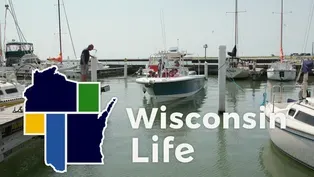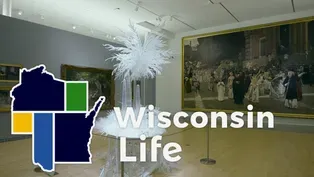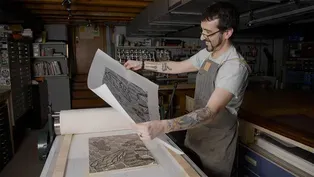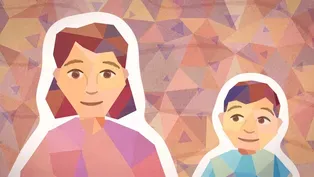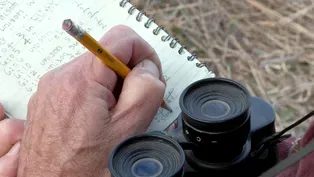
Blackhawk Ski Club in Middleton
Season 10 Episode 8 | 26m 48sVideo has Closed Captions
We explore the competitive side of winter sports with the Blackhawk Ski Club in Middleton.
Hit the slopes with Blackhawk Ski Club, a non-profit teaching competitive winter sports. Host, Angela Fitzgearld checks out cross-country skiing, biathlon training and high-flying ski jumps. Then we join an artist and tour guide at The Mining & Rollo Jamison Museum in Platteville and we explore our interstellar connection to Rib Mountain.
Problems with Closed Captions? Closed Captioning Feedback
Problems with Closed Captions? Closed Captioning Feedback
Wisconsin Life is a local public television program presented by PBS Wisconsin
Funding for Wisconsin Life is provided by the Wooden Nickel Fund, Mary and Lowell Peterson, A.C.V. and Mary Elston Family, Obrodovich Family Foundation, Stanley J. Cottrill Fund, Alliant Energy, UW...

Blackhawk Ski Club in Middleton
Season 10 Episode 8 | 26m 48sVideo has Closed Captions
Hit the slopes with Blackhawk Ski Club, a non-profit teaching competitive winter sports. Host, Angela Fitzgearld checks out cross-country skiing, biathlon training and high-flying ski jumps. Then we join an artist and tour guide at The Mining & Rollo Jamison Museum in Platteville and we explore our interstellar connection to Rib Mountain.
Problems with Closed Captions? Closed Captioning Feedback
How to Watch Wisconsin Life
Wisconsin Life is available to stream on pbs.org and the free PBS App, available on iPhone, Apple TV, Android TV, Android smartphones, Amazon Fire TV, Amazon Fire Tablet, Roku, Samsung Smart TV, and Vizio.
Providing Support for PBS.org
Learn Moreabout PBS online sponsorshipMore from This Collection
Holi Festival of Colors in Wausau
Video has Closed Captions
We celebrate the Holi Festival of Colors at the Monk Botanical Gardens in Wausau. (26m 49s)
Retzer Nature Center in Waukesha
Video has Closed Captions
Angela visits the wild side of Waukesha at the Retzer Nature Center and planetarium. (26m 48s)
Wisconsin Great Northern Railroad in Trego
Video has Closed Captions
All aboard the Wisconsin Great Northern Railroad for a historic ride in the Northwoods. (26m 48s)
Video has Closed Captions
We tour Riverview Gardens in Appleton, a non-profit offering job training and employment. (26m 48s)
Willow River State Park in Hudson
Video has Closed Captions
Explore Willow River State Park’s stunning waterfall, serene lake and endless trails. (26m 48s)
Sailing Education Association of Sheboygan
Video has Closed Captions
We learn about adaptive sailing with SEAS, the Sailing Education Association of Sheboygan. (26m 48s)
Museum of Wisconsin Art in West Bend
Video has Closed Captions
Celebrate artists in our state at MOWA, Museum of Wisconsin Art in West Bend. (26m 49s)
Providing Support for PBS.org
Learn Moreabout PBS online sponsorship- Announcer: The following program is a PBS Wisconsin original production.
[shimmery music] - Angela Fitzgerald: Coming up on Wisconsin Life: a group of friends counting... cranes, [crane whoops] a community leader helping others find their power, a printmaker carving wood blocks to create intricate artwork, and an animated tale exploring our interstellar connection to Rib Mountain.
That's all ahead on Wisconsin Life!
[inquisitive piano and gentle brass] - Funding for Wisconsin Life is provided by Lowell and Mary Peterson, Alliant Energy, donors to the Focus Fund for Wisconsin Programs, and Friends of PBS Wisconsin.
- Hello and welcome!
I'm your host, Angela Fitzgerald.
As daylight diminishes, we're traversing the trails and soaring down slopes with the Blackhawk Ski Club, a nonprofit dedicated to teaching young people and families competitive winter sports.
The club is located in the town of Middleton and provides 60 acres of perfect terrain to learn and get active.
Each winter, club members take part in a number of activities, including Nordic skiing, ski jumping, [clattering] biathlon training, alpine skiing, snowboarding, and more.
The nonprofit is celebrating more than 75 years in operation and was first formed in the post-World War II era when ski jumping was a popular sport.
They expanded into Alpine skiing and continue to grow.
Today, 375 families have annual memberships at the club.
Some of those include athletes training for competitions around the world.
When the snow melts, the club is still action-packed with challenging mountain bike trails that draw hundreds of riders each season.
The club is maintained and run by volunteers, who help with snowmaking and grooming.
Before we gear up to see the club in action, let's jump into our first story.
[shimmery music] Now, we head out to the fields of Marshall to join a trio on their annual crane count.
[cranes squawking] [string arpeggios, descending piano notes] [birds chirping energetically] - Mark Johnson: Before I met Hendrickson, I'd never seen a sandhill crane.
- My name is Mark Hendrickson.
- Well, my name is Mark Hanson.
[ding] - My name is Mark Johnson.
[ding] Among these other Mark(s), I'm 'Johnson.'
- Hanson: Johnson, [ding] Hendrickson, [ding] and Hanson.
[ding] We're part of a counting team for the crane species, in particular.
- Mark Hendrickson: The crane population, back in the 1930s, they were decimated, nearly extirpated from their home territory.
The crane count was started to monitor the populations.
Oh, yeah, yeah.
Yeah, good spot, good spot.
- Mark Hanson: It's a designated day of the year, usually mid-April.
[crane trumpeting] - Mark Hendrickson: The count is in seven states here in the Midwest.
Right now, I think Wisconsin has about 1,200 counters.
- Hanson: Hendrickson started doing this in the late '70s.
- Mark Hendrickson: It started in 1976.
I jumped on board in 1979.
I think I might be the longest one in Wisconsin doing it.
[laugh] Ah, you know, I'm not gonna brag about it.
We're asked to be out there from 5:30 until 7:30 in the morning.
[rewinding videotape] [laughter] Yeah.
[bell dings] - Mark Hendrickson: Round up here at our house at 4:00 in the morning, maybe a little before.
It's a 20-minute drive to the parking lot.
Holy cow!
Here we go.
Then, I've got something on... - Mark Johnson: And it's about a 45-minute hike back there, about a mile and a half.
[birds chirping] - Mark Hanson: The birds are most active during sunrise and just after.
That's why we get out there that early.
[lively birdsong] [rattling bugle call] - Hot dog!
- Mark Hanson: When we start hearing, it was still pretty dark.
5:58, maybe?
- Mark Hendrickson: Yeah, I'd say yeah.
- Mark Johnson: Is that a single, or...?
- Mark Hendrickson: That was a unison.
- Johnson: That was a unison.
- Mark Hendrickson: We're listening for two types of calls.
The unison call, [male and female cranes' duet call] which the male and the female do together.
The second call is like a warning call, [trumpeting warning] and it's if somebody ventures too close or if there might be a predatory animal nearby.
[crane calls assertively] "5:42 in 2017.
"A grand awakening, multiple unison calls.
We're estimating six birds."
- Mark Johnson: Luckily, Hendrickson keeps all the notes.
Hanson and I don't have to do anything, [chuckles] except look good.
- Mark Hendrickson: See him out there?
There was one that sounded close, but I don't know.
- No, yeah.
- Okay.
- Mark Hanson: We hear 'em and help each other, you know, identify 'em and point out where they might be.
There's one there!
- Flying over.
- Yeah, yeah, oh, yeah.
- Two of them, three of them!
- Hendrickson: Oh, boy!
- Hanson: There we go.
- Mark Hendrickson: Yeah!
- Hanson: It is right on cue, guys.
- Wow!
- I got lots to write down here.
- Johnson: Yeah.
[laughs] - Hanson: Better get going.
- Mark Hendrickson: Regarding my friends, Johnson and Hanson, who take part... the first two or three years doing this, I was on my own at the site.
And so, I mentioned to them, about, "How about coming along?"
They immediately accepted the invitation and have been vital to me in doing it and accompanying me in taking part in it.
- Mark Johnson: I have been doing the crane count since 1983.
- Mark Hanson: I've been doing the crane count since about 1980.
- Mark Johnson: So, that's about 40 years.
- Mark Hendrickson: We don't talk about why we do it or how much we like it.
- Mark Hanson: Well, I do it for the camaraderie with the guys, and I do it 'cause I'm interested in wildlife and nature.
- Mark Johnson: Mostly the tradition.
Watch the sunrise.
It's really special.
- Mark Hendrickson: It means a lot for your good friends to pick up on something like this, and take part, and be wholeheartedly interested in doing it.
- Johnson: I'd say both Hendrickson and Hansen are among my best friends.
- Mark Johnson: Good couple of guys, because we have a lot in common.
Just enjoying each other's company, joking around.
[laughing] - Johnson: He doesn't have any money.
[laughing] - Hendrickson: I got Apple Pay...
I got Apple Pay.
[laughing] - Oh, Apple Pay, that's right.
- Hanson: Oh!
- Mark Hendrickson: So, we're saying 26.
- Mark Hanson: That's a great total.
- Hendrickson: Yeah, yeah.
- A lot more than some years.
- Right, yeah.
- Mark Hanson: Yeah.
We have a good time.
We go out for breakfast afterwards usually, and make a good morning of it.
- Mark Hendrickson: We're people who are committed to the outdoors, to conservation, who love wild places, and like getting back and enjoying nature.
[purring crane calls] [shimmery music] - Up next, a Baraboo printmaker shares his intensive process creating intricate works of art.
[upbeat music] - Tim Znidarsich: The cool thing about printmaking is... the whole process behind the physicality of creating your print.
My name is Tim Znidarsich.
I'm an art teacher and printmaker in Baraboo, Wisconsin.
I specialize in woodcut, which is one of the more traditional techniques, where you use carving gouges and carving chisels to take away part of the surface on the woodblock.
And then, inking it up and printing it through an antique printing press, very similar to how newspapers were originally created.
Most of my work is me trying to capture a memory.
[playful music] I create some really quirky and funny images.
I make some really weird images.
[lion roaring] [bird chirping] I do series about odd animals.
I am fairly obsessed with trees.
[birdsong] Ornate flowers.
But I have so many weird ideas all the time that something just clicks and sparks and a whole series will come from that.
I usually start developing my idea on the iPad now.
I never thought I would be 'that person,' but the iPad is such a great tool, especially as a printmaker, for me to make changes to my drawing, to take bits and pieces of different places or ideas or even objects and merge them together.
After I have my image, I transfer it using a type of Japanese wax transfer paper.
That allows me to transfer my drawing onto a piece of wood.
Once I'm done using the transfer paper, there's a giant red outline of my drawing backwards on the woodblock.
And as I'm going and looking at the red lines, I go over everything in Sharpie.
It's kind of like it's your last rough draft before I start the labor-intensive process of carving.
When I'm carving, I find a sense of, like, melancholy.
It's very meditative for me.
It's very calming.
I can feel the pressure of the blade going right through the wood.
I can feel the resistance of the wood on my tools, taking a little piece out and taking more and more.
Hours can pass and, like, two, three, four hours, like, I'm just, like, in that moment.
And that moment just, like, stretches.
But that ultimate goal is finishing it, and striving to get to that point is what really keeps pushing me 'cause I want to see, is it gonna turn out the way I want it to?
'Cause even if it looks cool as it's being carved, you really have no idea what the print's gonna be until you print it.
[ink brayer rumbling] The final printing process, it's a culmination of hours and hours of all the hard work.
It's the end.
It can be tedious, but the challenging parts of pulling a final print always pays off.
Looking at the final print, it is the big moment where you see it for the first time.
It's exciting.
It's terrifying 'cause you're just praying and hoping that it's gonna turn out what you want.
Once you get it all the way off, you flip it over and you get to look.
There's something so special about that moment that you can feel.
Printmaking is kind of crazy.
It's extremely time-intensive.
You're gonna spend hundreds of hours creating an image, when the actual time to just print it is just a little bit.
But as a printmaker, it's a sense of accomplishment of putting your thoughts and your ideas into such a process-driven art form, and being able to translate that into a completely visual form for others and to know that you were able to achieve that.
♪ ♪ [shimmery music] - We're in Middleton with the Blackhawk Ski Club, checking out the programming here, from high-flying ski slopes to Nordic skiing with kids.
As the sun sets, the ski teams rev up with alpine jumps, downhill cruises, and rigorous biathlon training.
To tell me more, I met with Amy.
So, can you tell me a little bit more about what the Blackhawk Ski Club has to offer?
- This is one of the few places in the United States where all the different forms of skiing take place.
So, we have Alpine skiing, snowboarding, Nordic skiing, ski jumping.
We also have biathlon.
And then, in the summertime, we have mountain biking.
- And I noticed there's a lot of age variation here.
- Amy Grunewald-Mattison: So, we start our group lessons at age five, and then, around age 12, kids can either join the middle school ski team for Nordic skiing.
We also have an alpine race team.
And so, you can go in those directions.
Or a lot of kids just choose to continue skiing on their own.
- Very nice!
And this is kind of a training ground for those who want to competitively get into the world of skiing.
- Absolutely.
- Okay.
- And we started as a ski jumping ski club.
And I think our ski jumping program is really kind of the heart of who we are.
- In your opinion, what is so special about the Blackhawk Ski Club?
- The club really feels like a second family.
We all know each other really well.
To see so many different programs happening at the same time, and working relatively well together is just amazing to see.
I love how it is a sense of community and a place where my kids have really grown up.
Now, I'll get my chance to join the Blackhawk family and hit the cross-country ski trails.
But first, I needed a lesson from Amy and her friend.
- Oh, perfect!
- So, it's in there, okay.
- Now you do the same thing with the other one.
- All right.
I'm not going to fall?
- Well, sometimes we do fall.
[Angela laughs] - She's like, "I'm not going to make guarantees."
All right, I think... - And it might-- and you're in!
- So, I'm in there.
- Okay!
Now, you're going to give her her polls.
- Thank you.
- And you can kind of get, get a little up and down.
You want to bend your ankles and your knees.
And then, the idea is that you're going to kick and then glide, and kick, and then glide.
- Okay.
- So, you kick with one foot and glide with the other.
Just like that!
- Thanks, Amy!
- Amy Grunewald-Mattison: You're welcome!
- A successful lesson, and I stayed on my feet... for the most part, all thanks to the Blackhawk Ski Club.
Ahhhh!!!
[shimmery music] - It's now time to head to Madison to meet the founder of a nonprofit supporting people on their path to self-discovery and empowerment.
- How would you describe Urban Triage?
- Carola A. Gaines: It's the source of finding your being, not just as what you, you know, as a mother, as a wife, but, who are you?
And that is what Urban Triage, to me, is about: transforming lives of our Black community.
[upbeat, hopeful rhythmic singing] [birds singing] ♪ ♪ - Brandi Grayson: Urban Triage is birthed from my own personal experience in trauma-- being homeless, sleeping on the concrete, having a kid at a young age, having parents and a mother who was crack-addicted.
Having abusive grandparents and family members-- that feels safe.
Destruction feels safe.
So, Urban Triage is built on all of that experience, right?
And my own personal journey of navigating through this complex of inferiority that a lot of Black people have.
I would say most Black people have.
When you can understand why you act the way you act and understand how our brains are programmed to be and conditioned to be, then it becomes less about you, and more about the context, right?
The more I can detach and let go of all the physical and sexual abuse-- I was born into it, but it was not about me.
So, when I learnt how to do that or had that epiphany-- not even learn-- It's just like 'aha moment.'
Some things just come to you.
You're like, "Oh, my God!
Oh, my God!!!"
So, I took all of that and all that experience and built out Supporting Healthy Black Families curriculum.
My desire and vision to support Black families in navigating systems, in navigating institutions.
And, at the same time, understanding how we show up and being accountable for how we show up.
But not, like, being attached to how we showin' up.
Just like being, right?
It's okay who you are; it's okay!
Like, it's okay that you a mess.
It's okay that you don't have it all together.
It's okay that you're angry.
It's okay that, you know, that you have these inner stories.
Like, accepting all of those parts of us, and at the same time, being accountable for those parts of us.
And I think, like, in our society, we're taught that those two things can't exist at the same time.
That you can't be okay with who you are and be accountable at the same time.
But you can!
You can look at yourself in the mirror and say, "Girl, you a mess," right?
"And it's okay.
"It's okay that you a mess.
"It's okay you ain't got it figured out.
"It's okay that life is what it is.
"It's okay that you're hurt from all the crap that had nothing to do with you, right?"
I believe that in order to support those who are most vulnerable and disproportionately impacted by racism is that we gotta lead them on their own journey of 'aha moments.'
They gotta get it.
Like, they have to have that mental thing that clicks for them, right?
Because, if not, then we keep just living in Groundhog Day.
We keep living in the past, bringing it to our now, projecting it to the Future.
And then, we get locked in into this cycle, and that's-- and that-- And I learnt that from my experience of just existing.
How do you become accountable for you right now?
How do you look at your life and say, "I'm in a toxic relationship that's not working?
"I have not been showing up for myself.
"I'm living an unhealthy life," right?
And be accountable for those parts, right.
And when people start taking action in their life, it shows up everywhere in their life.
So, we have people who come through our work groups that's left abusive marriages, that have went to therapy with their kids, and are more present, learnt to listen to their kids, and quit a job and started businesses, and start believing in their self.
And these are people that would never even think that they would ever do such a thing.
Your past, your history, it's not your story, you know.
It's not it; it's just a part of it.
And we get to use the experience, our experiences, to cause and create whatever we want, you know.
Like, we really do get to live a good life.
No matter what's on the movies, what's on the news, we get to live a good life, and you get to live it by choosing it.
And you can choose it, and then, align to it.
I deserve the world.
I'm worthy of this.
I'm worthy of goodness.
I'm worthy of a good life.
Like, that is everything.
So, my message to every person who sees this is be true to you.
Keep going, regardless of what you're facing or what's in front of you, know that it is you that causes and creates.
It is your thoughts; it is your belief.
So, in a face of adversity, challenges, obstacles, naysayers, just keep going.
You gotta keep going.
[peaceful melody] [shimmery music] - Our last story is an animated tale.
We catch up with a mother and son exploring our interstellar connection to Rib Mountain.
[ethereal music, birds chirping] [footsteps crunching] - Mother: I want my 4-year-old son to climb a mountain; not so easy in Wisconsin.
[spinning sunglasses make 'skedaddle' sound] Long ago, mountains as high as the Rockies covered the area which is now our state.
But today, I'll have to settle for 1,942-foot Rib Mountain.
It's a remnant of that ancient Rocky-sized range, buried by sediment, then revealed through erosion.
I'm not concerned by the modest elevation because this mountain sports something more impressive: its age.
Rib Mountain contains some of the oldest rock in the world.
At 1.7 billion years old, these rocks have been around for more than a third of the Earth's existence.
We rub our hands across the striations on the side of a boulder, made by waves when the now quartzite was a river valley or ocean bottom.
"Long ago, this rock used to be sand," I say.
I am awed by this evidence of the rock's previous forms.
First sand, then sandstone, now quartzite.
I tell my son to think about the ripples the ocean makes along the seashore.
He gets it.
Looking around the heavily wooded mountaintop and responding, "There must not have been any trees here then."
Next, I tell him the rock's age, knowing full well his understanding of such things still has a long way to go.
His own number of fingers and toes as yet a daily discovery.
This window of not-yet-complete awareness of his own form might be a good time, I figure, to convince him of what we, like the rock, really are-- "The rock is old," I say to my son, "But you and the rock are really the same age, "around 13.8 billion years old.
"The atoms in your body and the atoms in the rock "made just after the birth of the universe "and in exploding stars.
You are stardust."
"Stardust," he repeats, and smiles.
He's heard me say it before.
I want my son to take the long view, to think like a mountain, even when he is not on the mountain, and not only about the Earth, as Aldo Leopold imparted, but about himself.
We should not get mired in how one strand of identity formulates us.
But consider all the strands: the food we eat, the microbes we host, where we grow up, and the DNA we inherit; no more or less important than the atoms that make up all this stuff.
I don't deny what we appreciate in the rock, its consistency of form, being itself, over such an unimaginable period of time.
It's old; it's something; it has exactly the sort of permanence we ourselves desire.
I come to the mountain today not only in a parent's feeble attempt to make my son seem immortal but to help him better navigate life's journey-- its hard facts, as well as its uncertainties.
[wind and rumbling skies] A hundred years, the most humans can expect, is not much.
Yet over that hundred years, our solid seeming body is in constant change; individual cells live from a few days to at most 10 years, continuously rebuilt from materials from our immediate environment.
We are not sandstone, then quartzite, for a billion years or even human for one hundred.
We are sea, land, and sky all in one lifetime.
[object whooshing through the cosmos] [gentle, dramatic acoustic guitar] [shimmery music] - Night has fallen, but I haven't... yet.
We've toured the state, sharing the people and places we love, like right here with the Blackhawk Ski Club.
Check out our collection of radio and TV stories by visiting WisconsinLife.org.
Follow us on our social channels or email us at Stories@WisconsinLife.org.
Until next time, I'm your host, Angela Fitzgerald, and this is our Wisconsin Life.
Bye!
[soaring guitars, strings, energetic drums, moving piano] [bike sprockets clicking] - Announcer: Funding for Wisconsin Life is provided by Lowell and Mary Peterson, Alliant Energy, donors to the Focus Fund for Wisconsin Programs, and Friends of PBS Wisconsin.
Video has Closed Captions
Baraboo artist Tim Znidarsich demonstrates the intensive process of printmaking. (4m 54s)
Video has Closed Captions
Visiting Rib Mountain, Jill Sisson Quinn teaches her son about our place in the universe. (4m 31s)
Video has Closed Captions
A look into the transformative work of Urban Triage and its founder, Brandi Grayson. (5m 19s)
Video has Closed Captions
Trio of friends mark tradition with four decades of crane counting. (5m 56s)
Providing Support for PBS.org
Learn Moreabout PBS online sponsorshipSupport for PBS provided by:
Wisconsin Life is a local public television program presented by PBS Wisconsin
Funding for Wisconsin Life is provided by the Wooden Nickel Fund, Mary and Lowell Peterson, A.C.V. and Mary Elston Family, Obrodovich Family Foundation, Stanley J. Cottrill Fund, Alliant Energy, UW...

